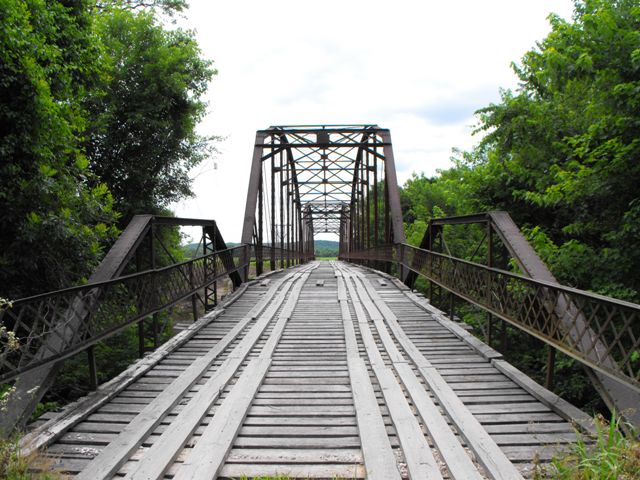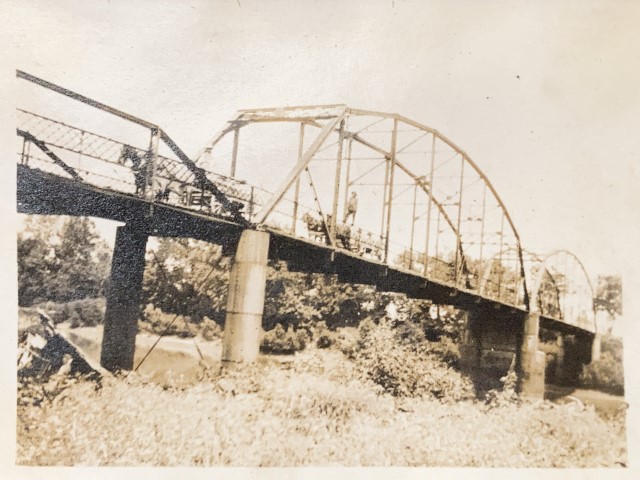We Recommend:
Bach Steel - Experts at historic truss bridge restoration.
BridgeHunter.com Phase 1 is released to the public! - Visit Now
Dicks Bridge
Imhoff Road Bridge

Primary Photographer(s): Nathan Holth and Rick McOmber
Bridge Documented: July 3, 2009
Rural: Cooper County, Missouri: United States
Metal 8 Panel Pin-Connected Parker Through Truss, Fixed and Approach Spans: Metal Pin-Connected Queenpost Pony Truss, Fixed
1908 By Builder/Contractor: Kansas City Bridge Company of Kansas City, Missouri
Not Available or Not Applicable
160.0 Feet (48.8 Meters)
390.0 Feet (118.9 Meters)
14.1 Feet (4.3 Meters)
2 Main Span(s) and 3 Approach Span(s)
12954

View Information About HSR Ratings
Bridge Documentation
View Archived National Bridge Inventory Report - Has Additional Details and Evaluation
This bridge is an extremely significant structure as a large, multi-span pin-connected truss bridge built by a noted regional bridge builder. It contains two impressive Parker truss main spans. This bridge also contains three approach spans. At the eastern end of the bridge, there are two girder and floorbeam (deck plate girder) spans. They are small spans and the girders are rolled beams. At the western end of the bridge there is something extremely rare and noteworthy, a Queenpost truss.
The bridge retains excellent historic integrity including original lattice railings, wooden deck, and an unaltered truss structure. The truss bridge includes caisson piers.
There used to be many more truss bridges like this one in Missouri, but they have mostly been demolished. While a few others do still remain, the number surviving is extremely small. Among the surviving examples, this bridge stands out as a long example with excellent historic integrity. Whether it is preserved for continued use or bypassed by a modern bridge, this bridge must not be destroyed.
Matt Kuehnert contacted HistoricBridges.org and provided some insight in the bridge's name. His great grandfather was Frederick Dick who owned a farm near Boonville. His father was Peter Dick, who owned nearby Dick's Mill with his brother Adolph after the civil war.
Above: Historical photo of bridge, courtesy Matt Kuehnert
Information and Findings From Missouri's Historic Bridge InventoryBridge Features Superstructure: steel, 8-panel, pin-connected Parker
through trusses; one 50-foot, 3-panel, pin-connected Pratt pony truss
approach span at west end and three steel stringer approach spans at
east end Substructure: concrete abutments and wingwalls with
concrete-filled steel cylinder piers Discussion of Bridge In May 1907, the Cooper County Court conditionally announced that it would rebuild the Dicks Bridge if the local citizenry would pay for one-half its estimated cost. Located over the Lamine River some three miles southeast of Blackwater, the existing structure here had deteriorated beyond the point of repair. County road and bridge commissioner, E.T. Hale, presented the following month his estimate of $6000.00 to construct the Dicks Bridge. He noted that the previous bridge's masonry abutments and steel cylinder piers were largely salvageable, but would need to be elevated approximately four feet. Competitive bids for the reconstruction project were received on August 5, 1907. The Kansas City Bridge Company of Missouri, a prominent contractor in Cooper County, was awarded the contract for this and other structures, totaling $49,600.00. To the discouragement of the county court, local citizens eventually only met a fraction of this amount. The contract for improving the existing abutments was awarded in November to Charles Hutchinson for $5.75 per cubic yard. Hutchinson also handled the re-erection of several piers which had collapsed or were missing. Completed in early May the next year, the Dicks Bridge, a pin-connected Parker through truss, continues to retain a strong degree of visual integrity. As one of Missouri's most prolific bridge fabricators, the Kansas City Bridge Company maintained an extensive catalogue of truss types, ranging from the exotic to the commonplace. KCBCo, like most of the region's bridge builders of the time, relied heavily on pin-connected Pratt truss variants for its standard truss types. After the turn of the century, however, KCBCo began fabricating polygonal-chorded Pratt variants (particularly Parkers) for long-span applications. Their relatively long spans, light structural members and archaic detailing have rendered pin-connected Parker trusses particularly vulnerable to subsequent replacement. As a result, of the hundreds that once carried vehicular traffic throughout the state, fewer than three dozen remain in place today. These range in span length from 110 feet to 200 feet and in erection date from 1900 to 1932. The Dicks Bridge, with its 160-foot span and 1908 construction date, falls within the mainstream of this trend. It is noteworthy for its excellent state of preservation and its two-span configuration. Bridge Considered Historic By Survey: Yes |
![]()
Photo Galleries and Videos: Dicks Bridge
Bridge Photo-Documentation
Original / Full Size PhotosA collection of overview and detail photos. This gallery offers photos in the highest available resolution and file size in a touch-friendly popup viewer.
Alternatively, Browse Without Using Viewer
![]()
Bridge Photo-Documentation
Mobile Optimized PhotosA collection of overview and detail photos. This gallery features data-friendly, fast-loading photos in a touch-friendly popup viewer.
Alternatively, Browse Without Using Viewer
![]()
Maps and Links: Dicks Bridge
Coordinates (Latitude, Longitude):
Search For Additional Bridge Listings:
Bridgehunter.com: View listed bridges within 0.5 miles (0.8 kilometers) of this bridge.
Bridgehunter.com: View listed bridges within 10 miles (16 kilometers) of this bridge.
Additional Maps:
Google Streetview (If Available)
GeoHack (Additional Links and Coordinates)
Apple Maps (Via DuckDuckGo Search)
Apple Maps (Apple devices only)
Android: Open Location In Your Map or GPS App
Flickr Gallery (Find Nearby Photos)
Wikimedia Commons (Find Nearby Photos)
Directions Via Sygic For Android
Directions Via Sygic For iOS and Android Dolphin Browser
USGS National Map (United States Only)
Historical USGS Topo Maps (United States Only)
Historic Aerials (United States Only)
CalTopo Maps (United States Only)


